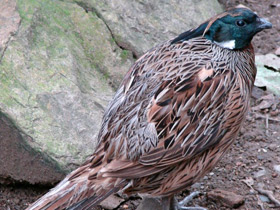The koklass pheasants Pucrasia
The koklass pheasant is the only species in the genus Pucrasia. The koklass pheasants are thought to be related to both monals and tragopans, but researchers believe that they are more closely affiliated to the tragopans. The species includes nine subspecies classified according to their geographical distribution. The ranges of the koklass subspecies are geographically isolated. These birds are distributed in Afghanistan, Pakistan, India, Nepal, China, and Mongolia. Koklass pheasants inhabit coniferous and mixed forests with a dense understory of bamboo, rhododendron, and other shrubs. Koklass are found in steep slopes at 1,200–4,200 meters above sea level. Their wintering grounds are located at elevations of 2,200–2,500 meters (sometimes even 600 m). These pheasants are medium-sized birds, measuring 58–64 cm in body length, with the tail being 23 to 24 cm long. They weigh 0.9 to 1.4 kg. Koklass have a head-crest of the narrow, elongated feathers, which rise, when the male is displaying. The back of both males and females of the koklass pheasant is covered with silver grey, lanceolate feathers. The tail is flattened, with the feathers in the centre being twice as long as the outer feathers. The head and bill are black. Koklass pheasants have spurs on the legs.
In the wild, koklass do not aggregate in large flocks but live in small family groups. They spend nighttimes roosting on trees. Outside of the breeding season, these birds are very secretive and usually skulk in dense scrub thickets, though when startled, they noisily take into the air, producing loud warning calls. They do not move much during the day and could be seen on the same sites at any time of the day. They tend to forage in the forest clearings surrounded by bushes, which these birds use as a protection against predators. Koklass pheasants in Pakistan prefer roosting in pine trees, consuming large amounts of pine needles. The Chinese name for this species, “Sung chi”, meaning pine chicken, apparently refers to the tendency of the koklass to roost in pines and to consume its needles.
Koklass pheasants are monogamous and seem to maintain pair bonds during most of the year. The breeding season lasts from April–June through July, depending on local conditions. In India, the breeding season lasts from April to June. Most nests are built under thick evergreen bushes, on the hillsides in coniferous forests. The nests are sometimes sheltered by ferns, though they could be located in the thickets of briars, raspberries, or other thorn bushes, where they are well hidden from view. Sometimes the nest is wedged amongst tree roots, and in such cases, the birds access the nest through the gap between the roots; it is almost impossible to see such nests. The presence of thick undergrowth and perhaps a proximity to water appear to be the major pre-requisites for nesting in this species. The female usually lays 5 to 6 eggs, but clutches with 8 or 9 eggs were also observed. The female incubates the clutch alone, but the male always stays close to the female. Incubation period is 26 or 27 days. Males participate in brood-rearing process. The koklass hatchlings are highly precocial and are able to fly well within only a few days. Young birds reach sexual maturity in their first year of life, and probably young males start breeding next spring. The diet of koklass pheasants includes both plant materials, such as cereals, grass seeds, acorns, berries, buds, and flowers, and animal foods – various insects, molluscs, and worms.
















































